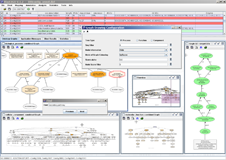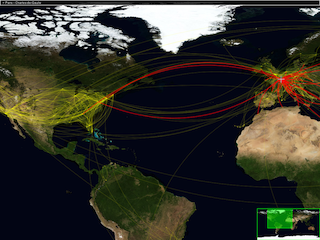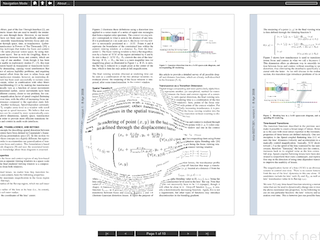Section: Software
The Zoomable Visual Transformation Machine
Participants : Caroline Appert, Rodrigo de Almeida, Olivier Chapuis, Arjit Gupta, Emmanuel Pietriga [correspondant] , Mathieu Nancel, Romain Primet.
ZVTM provides application programmers with building blocks for implementing complex multi-scale interface components that cannot be handled by traditional WIMP widgets. Featuring off-the-shelf visualisation and navigation components that are easy to combine, ZVTM provides a simple yet powerful API and handles low-level operations such as multi-threading, clipping, repaint requests and animation management. The toolkit is based on the metaphor of universes that can be observed through smart movable/zoomable cameras. The graphical object model permits management of a large number of complex geometrical shapes. It emphasizes perceptual continuity via an advanced animation module that can animate virtually any on-screen modification. This ranges from camera movements and activation of distortion lenses to modification of the visual variables of graphical objects. Various temporal pacing functions are available to control the execution of these animations. ZVTM is now one of the core components of our jBricks toolkit for wall-sized displays (Section 5.1 ), and current development activities around the toolkit focus on making applications run transparently on cluster-driven ultra-high-resolution wall-sized displays such as that of the WILD visualization platform. The toolkit is also used to develop advanced visualization components for the ALMA observatory's operations monitoring and control software [26] .
Initially developed by Xerox Research Centre Europe and the World Wide Web Consortium (W3C) team at MIT, ZVTM has been available as open-source software under the GNU Lesser General Public License (LGPL) since early 2002. It is used in both academic and industrial projects such as IsaViz (http://www.w3.org/2001/11/IsaViz/ ), W3C's visual browser/editor for RDF, Blast2GO (Figure 2 - left) (http://www.blast2go.org/ ), or ZGRViewer (http://zvtm.sourceforge.net/zgrviewer.html ) for viewing large graphs generated by AT&T GraphViz (http://www.graphviz.org ) (Figure 2 - right). The development of the toolkit is now supported by Inria. More information can be found at http://zvtm.sourceforge.net and [52] and [51] .
ACM: H.5.2 [User Interfaces]: Graphical user interfaces (GUI)
Software benefit: See Pietriga, A Toolkit for Addressing HCI Issues in Visual Language Environments, IEEE Symposium on Visual Languages and Human-Centric Computing (VL/HCC '05), pages 145-152, September 2005
Required library or software: several, managed through Maven





